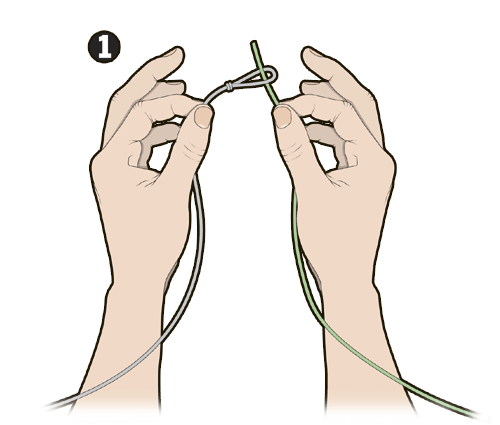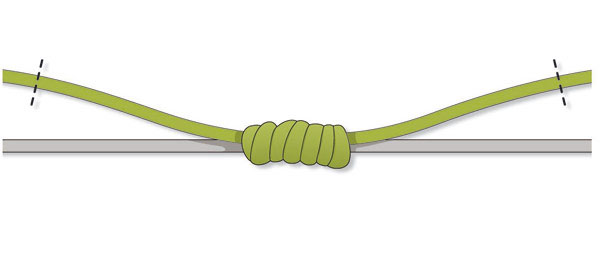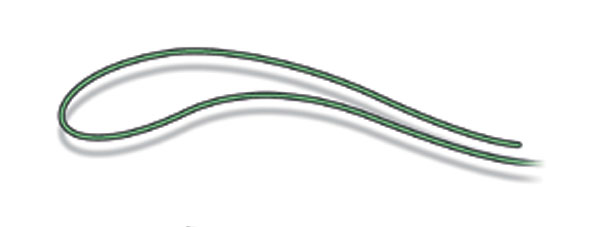How to tie Alan Scotthorne's Hooklength Knot
Here Alan Scotthorne reveals the knot that he uses to join a hooklength to his fishing mainline. It's a variation of the loop-to-loop method, but with a twist. It's easy to tie and incredibly strong...
Alan Scotthorne was never really happy with using loop to loop knots for joining his mainline to his hooklength namely because it can potentially cause tangles and it's untidy.
After experimenting with lines he came up with this knot. Well, it's actually not really a knot - it's more of a way of wrapping and twisting a line onto a loop of line. This makes this knot very strong indeed, and therefore reliable enough to be used on silverfish through to commercial carp waters.
But it's developer and creator proves just how reliable and effective this knot it. If it's good enough to a five-times World Champion to use, it must be good enough for every other angler!
Here's how it's tied...
1 Tie a small loop in the end of your mainline and then pass your hooklength line through the loop like this.
2 Hold the line in your left hand and then double it up with your other hand to create a loop in the hooklength line.
3 Twist the end of the hooklength that is held in your right fingers. This causes the line to spin and twist around the other section of hooklength line.
4 Pass the other end of line, with your hook attached, through the loop that is created when twisting the hooklength line.
5 Moisten the line and pull the knot tight. The tag ends should be trimmed right down as this knot refuses to slip.
How to tie the stop knot
The Stop Knot is commonly used by match anglers who need to floatfish a waggler in water much deeper than the length of their rod, but it is even more commonly used by predator anglers when they create their float rigs.
A well-tied Stop Knot provides a moveable point that helps prevent your float from sliding all the way along your mainline, and if it is tied using a length of flexible mono, it will cast through the rings of any match rod on the market.
Specialist anglers tend to use powergum to tie their stop knots, which will still pass through their rod's rings because of the large internal diameter of them.
STEP 1
Lay a 6in length of powergum or thick mono alongside your mainline.
STEP 2
Form a loop with the powergum or mono and thread one end through the loop and over your mainline.
STEP 3
Repeat threading the powergum or thicker mainline through the loop and around your mainline four or five times.
STEP 4
Moisten the knot with saliva, slide it into position upon the mainline then pull it tight. Trim the tag ends to around an inch from the knot.
How to tie the water knot
This knot has many uses for the angler. It can be used to link hooklength to mainline, it can be used to join a paternoster link to a mainline, and it can even be used to join mono to braid.
Many angler's use this knot to link their pole mainline to the hooklength, especially when fishing delicate rigs, because it is far more direct than the more commonly used loop to loop technique.
STEP 1
Lay the two lines you wish to tie alongside each other.
STEP 2
Form a substantial loop using the two lines
STEP 3
Ensure the two lengths of line are together and thread the pair of tags ends through the loop three times.
STEP 4
Moisten the knot with saliva or water and slowly pull it tight. Trim off the tag ends accordingly to either create a straight profile when joining a mainline to hooklength, or cut the tag ends to create a paternoster link for legering purposes.
How to tie the overhand loop knot
If you are seeking a knot for tying your hooklength to the end of your fishing mainline, the overhand loop knot is absolutely perfect...
It's a really easy knot to tie and when tied correctly and used correctly, will provide a small loop that can be used to lock on another loop in another length of line - for example, your hooklength or ready-tied hooklengths.
The best thing about using this knot and method to attach two lengths of line together is that if you push the knots together after the loops have been joined together, you can actually thread the hooklength out from the mainline loop making it really quick and easy to switch to either a thinner or a thicker hooklength in seconds.
Here's how to tie the overhand loop knot...
STEP 1: Double your mainline to create a large loop
STEP 2: Fold the loop over to form another loop.
STEP 3: Pass the first loop at least twice through the second loop.
STEP 4: Moisten the knot with saliva and pull it tight. Trim the knot and you are away.
STEP 5
Follow the same process with your hooklength and pass it through.
USING THE OVERHAND LOOP KNOT TO ATTACH A LOOP TO ANOTHER LOOP
How to tie a tucked water knot
Follow the steps below to learn how to tie a tucked water knot...
Place a shorter length of leader, say about 12 inches, next to the main leader as shown.
Now make a loop with both lengths making sure they remain together as one. You’re now ready to for the knot.
Pass the the loose ends (furthest from the fly line) through the loop at least two times. Many anglers prefer three or four times.
Moisten the knot and pull ends tight so the knot beds down neatly. Choose the loose end pointing towards the point fly as the dropper.
To make your droppers stick out away from the main leader, take the loose end (pointing away from the fly line) and tuck.
Moisten and gently draw tight. NOTE: This tucked knot suits standard mono and not fluorocarbon.




























